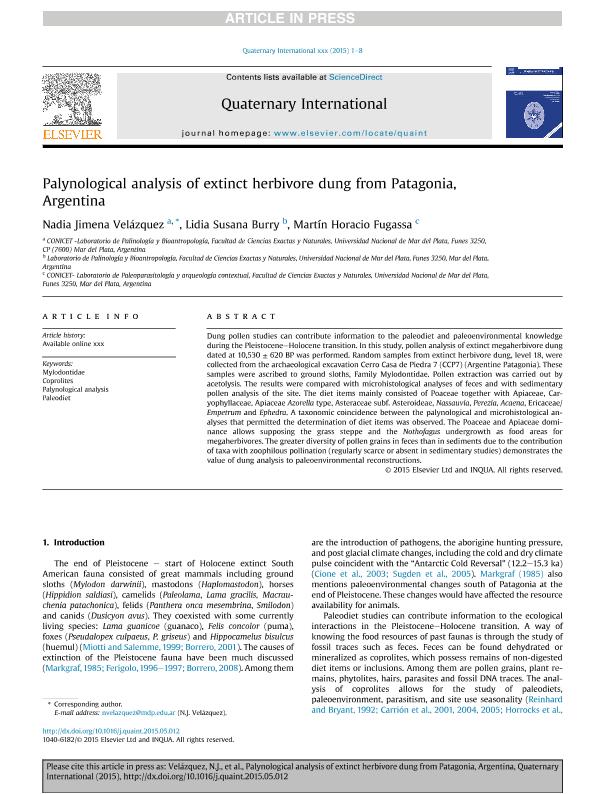Artículo
Palynological analysis of extinct herbivore dung from Patagonia, Argentina
Fecha de publicación:
05/2015
Editorial:
Pergamon-Elsevier Science Ltd
Revista:
Quaternary International
ISSN:
1040-6182
Idioma:
Inglés
Tipo de recurso:
Artículo publicado
Clasificación temática:
Resumen
Dung pollen studies can contribute information to the paleodiet and paleoenvironmental knowledge during the Pleistocene-Holocene transition. In this study, pollen analysis of extinct megaherbivore dung dated at 10,530 ± 620 BP was performed. Random samples from extinct herbivore dung, level 18, were collected from the archaeological excavation Cerro Casa de Piedra 7 (CCP7) (Argentine Patagonia). These samples were ascribed to ground sloths, Family Mylodontidae. Pollen extraction was carried out by acetolysis. The results were compared with microhistological analyses of feces and with sedimentary pollen analysis of the site. The diet items mainly consisted of Poaceae together with Apiaceae, Caryophyllaceae, Apiaceae Azorella type, Asteraceae subf. Asteroideae, Nassauvia, Perezia, Acaena, Ericaceae/. Empetrum and Ephedra. A taxonomic coincidence between the palynological and microhistological analyses that permitted the determination of diet items was observed. The Poaceae and Apiaceae dominance allows supposing the grass steppe and the Nothofagus undergrowth as food areas for megaherbivores. The greater diversity of pollen grains in feces than in sediments due to the contribution of taxa with zoophilous pollination (regularly scarce or absent in sedimentary studies) demonstrates the value of dung analysis to paleoenvironmental reconstructions.
Palabras clave:
Coprolites
,
Mylodontidae
,
Paleodiet
,
Palynological Analysis
Archivos asociados
Licencia
Identificadores
Colecciones
Articulos(CCT - MAR DEL PLATA)
Articulos de CTRO.CIENTIFICO TECNOL.CONICET - MAR DEL PLATA
Articulos de CTRO.CIENTIFICO TECNOL.CONICET - MAR DEL PLATA
Citación
Velázquez, Nadia Jimena; Burry, Lidia Susana; Fugassa, Martín Horacio; Palynological analysis of extinct herbivore dung from Patagonia, Argentina; Pergamon-Elsevier Science Ltd; Quaternary International; 377; 5-2015; 140-147
Compartir
Altmétricas




